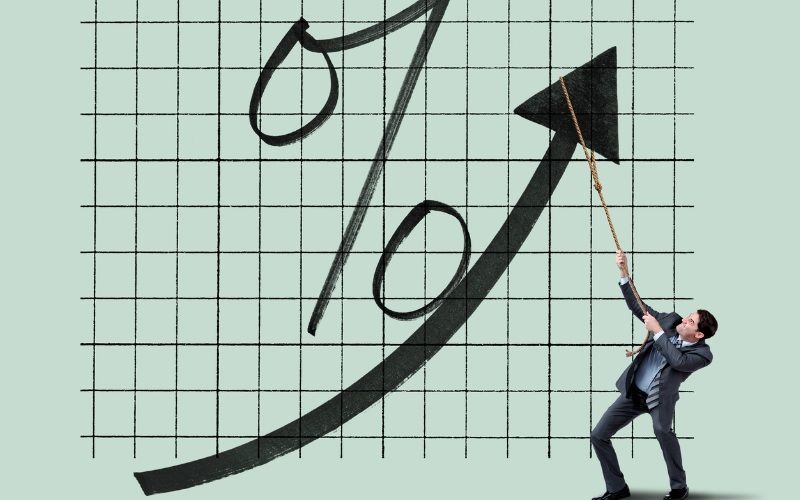Last Updated: July 12, 2024
Understanding and Managing Fluctuating APRs

Disclaimer: We are not qualified legal or tax professionals and are not giving advice. Always speak with a qualified professional before making any legal or financial decisions.
Have you ever opened your credit card statement only to find that your balance has grown unexpectedly? This increase often stems from a rising credit card interest rate, a scenario that can significantly amplify your financial strain, particularly if you're already juggling multiple balances. In today's dynamic financial landscape, several factors can trigger these unexpected hikes, including shifts in the prime rate, changes in your credit score, or even the card issuer's policy adjustments.
This guide looks into the reasons behind fluctuating credit card interest rates and outlines practical steps you can take to mitigate their impact on your wallet. Whether it's through smart balance management, negotiating with your card issuer, or exploring debt consolidation options, there's a strategy to help you regain control and keep your debt costs manageable.
Understanding and actively managing your credit card APR (Annual Percentage Rate) is crucial for maintaining financial health in an ever-changing economic environment, where a seemingly small change in interest rate can have substantial long-term effects on your overall debt.
Immediate debt questions? Get immediate answers from a debt specialist. Click for a free consultation.
How Credit Card Interest Rates Work
The Annual Percentage Rate (APR) on your credit card determines the interest you pay on carried balances. This credit card interest rate can be fixed or variable, with most cards linking their variable APR to the prime rate. Understanding your APR is crucial, as it directly affects your debt over time.
The APR and interest rate are essentially the same for credit cards, though some cards may offer different rates for various transaction types. Many issuers also provide attractive introductory APRs that later transition to standard rates, making it important to read the fine print carefully.
What Factors Determine Your Credit Card's APR?
Several key factors determine the APR you receive when you open a new credit card or carry a balance on an existing card:
- Credit Score: The higher your score, the lower the risk you are in the eyes of lenders. Good credit scores can qualify you for lower APRs.
- Credit History: The length of your credit history and how responsibly you've managed debts in the past also impact the interest rate you receive.
- Type of Card: Cards aimed at consumers with excellent credit tend to have lower APRs than cards serving those working to build or rebuild credit.
- Prime Rate: Since most credit cards link to the prime rate, shifts in this underlying rate impact your APR.
Your credit report and profile lead the credit card company to assign you a rate based on their assessment of your creditworthiness as a borrower.
How Does Credit Card Interest Accrue?
When you carry a balance from a credit card bill from one billing cycle to the next, interest starts accruing.
Here is how it works:
- Each day, your average daily balance is calculated, including any new charges made and payments or credits received.
- Your card issuer will take your APR and divide it by 365 to get your daily periodic rate.
- The daily periodic rate is then multiplied by your average daily balance to determine the interest owed for that day.
- At the end of your billing period, the total interest accrued that cycle is added to your balance.
If you consistently carry an unpaid balance transfer credit card, interest compounds each month. This means you pay interest on your existing interest, causing balances and interest charges to rapidly snowball. It's a good idea to pay attention to the difference between simple and compound interest to understand how quickly growing credit card balances can get out of hand.
Reasons Your Credit Card APR Can Go Up
You might be wondering, 'Why did my APR go up?' While having a variable rate means your credit card APR can fluctuate regularly, there are specific circumstances that typically trigger credit card interest rates to rise. These include changes in the prime rate, late payments, the end of promotional periods, and shifts in your credit score.
The Prime Rate Changed
Most credit cards tie their APR to the prime rate, which fluctuates based on economic factors and Federal Reserve decisions. When the prime rate rises, your card's variable credit card interest rate typically follows within one or two billing cycles. For instance, a 0.25% increase in the prime rate would lead to a corresponding 0.25% hike in your credit card interest rate if your card charges prime plus 10% APR. Recent Federal Reserve actions, including multiple rate hikes in 2022 to combat inflation, have led to widespread increases in credit card rates, with more potentially on the horizon.
You Made a Late Payment
Late credit card payments can have severe consequences beyond just fees. If your payment is 60 days overdue, many card issuers will impose a penalty interest rate, often exceeding 25%. This steep increase in your credit card interest rate can apply to both existing balances and new transactions, significantly inflating your debt. Some companies may even trigger this penalty with just one late payment.
Cardholders often find themselves stuck with these elevated rates for six months or longer unless they demonstrate consistent, timely payments. To avoid both late fees and punitive rates, it's crucial to understand your credit card interest rate terms and make at least the minimum payment by the due date each month.
Your Introductory Offer Ended
Balance transfer and 0% introductory APR offers provide temporary financial relief, but it's crucial to understand that they typically last only 12 to 18 months before reverting to the standard credit card interest rate. To avoid unexpected charges, keep track of when regular APR terms take effect and be cautious of overspending during the promotional period, as any remaining balance will be subject to higher rates once the offer expires.
Your Credit Score Dropped
Card companies periodically review accounts, potentially raising rates if your credit score drops significantly. This increase in credit card interest rate typically occurs in increments based on your risk profile. You'll receive advance written notice of any changes, so review these carefully. To mitigate the impact of higher rates, which can sometimes double, focus on improving your credit standing and paying down balances proactively.
When Your Credit Card Company Can Raise Your Rate
In most cases, credit card companies cannot arbitrarily decide to jack up your interest rates unexpectedly. However, there are specific scenarios where your credit card issuer still has the right to increase your APRs.
After a 12 Month Introductory Period
Balance transfer or 0% APR promotions typically last 6-12 months for new cardholders. Once this period ends, the credit card interest rate reverts to higher standard variable terms, affecting both remaining transferred balances and new purchases. It's essential to plan for this transition to avoid unexpected interest charges.
60+ Days Late on Payments
As mentioned earlier, making late credit payments 60+ days past the due date triggers penalty APRs from most credit card issuers. This also allows them to apply the considerably higher interest rate to existing account balances.
Credit Score Drops Substantially
A substantial drop in your credit score, particularly 100 points or more, can signal increased risk to card issuers. In response, they may raise your credit card interest rate to compensate for this perceived risk. Typically, this increase can result in rates around prime plus 25% or higher, depending on factors such as your payment history and overall creditworthiness.
Variable Rate Tied to Prime & Prime Rate Increases
Since prime rate changes directly cause corresponding variable APR adjustments, major federal reserve moves like the 2022 rate hikes trickle down to consumers. Prime-linked card rates rise in lockstep with these federal rate changes.
It's Been At Least 12 Months Since Account Opening
Credit card issuers are restricted from raising interest rates in the first year of account opening. However, after 12 months, they can adjust your credit card interest rate even without specific risk factors like late payments or credit score drops. Understanding these policies is crucial for managing potential rate increases. Now, let's explore strategies to handle the financial impact of such changes.
Steps to Take When Your Interest Rate Increases
Seeing your credit card APR shoot up unexpectedly can be stressful. Luckily there are a few options at your disposal to handle climbing interest rates proactively.
Pay Down Credit Card Balances
Higher credit card balances amplify the impact of rising interest rates. To combat this, develop a debt repayment strategy like the debt avalanche or snowball method. Consider budgeting, increasing income, or debt consolidation to lower your credit card interest rate and accelerate paying off credit card balances. Each extra dollar applied to debt today saves significantly on future interest charges.
Transfer Balances to a Lower APR Card
For consumers dealing with substantial debt, transferring balances to a card with a lower credit card interest rate can provide temporary relief. Many issuers offer 0% introductory APR periods for 12-15 months, but be mindful of balance transfer fees (typically 3-5%). Calculate whether interest savings exceed these fees and plan to pay off the balance before the introductory period ends to maximize the benefits of this strategy.
Consolidate Debt with a Personal Loan
Personal loans offer a way to consolidate high-interest credit card balances, often securing a lower, fixed credit card interest rate over a 2-5-year term. This strategy can provide more predictable monthly payments and help manage debt, but it's crucial to avoid accumulating new charges on the paid-off credit cards after consolidation.
Get Professional Help to Negotiate with Your Card Issuer
Consider reaching out to a professional debt relief company like Pacific Debt Relief to negotiate with your creditors. The worst that can happen is denial, but with expert assistance, your chances of success are significantly improved.
Avoiding High Interest Rates Altogether
While economic factors lead interest rates to fluctuate over time, you aren't necessarily stuck paying sky-high credit card APRs forever.
Pay Statement Balances in Full Each Month
When it comes to credit card interest, the best defense is avoiding it completely. Pay your full statement balance by each due date to never pay interest charges. Without lingering balances, rate changes won't hit your wallet quite as hard. Automate payments or set calendar reminders to pay your bill on time without rolling unpaid balances between billing cycles.
Shop For Low-Interest Rate Credit Cards
Paying your balance in full each month is ideal, but when that's not possible, choosing cards wisely becomes crucial. Opting for cards with lower, fixed credit card interest rates, often between 11-15%, can provide substantial savings compared to variable rate cards that typically charge prime plus 10% or more. This strategy, especially during debt repayment periods, can help control interest costs and make your path to becoming debt-free more manageable.
Keep Credit Card Balances Low
Utilization (balances versus credit limits) also indirectly impacts the interest rates you pay. Keeping your average credit card debt and balances under 30% of total credit limits helps your credit score and long-term eligibility for lower-interest accounts with better terms.
Monitor Credit Reports Regularly
Enrolling in free credit monitoring services allows you to track your reports and scores monthly. This vigilance helps you quickly identify and dispute errors, as well as address any dips that could trigger a credit card interest rate increase. By maintaining excellent credit, you ensure access to the lowest available rates, potentially saving significant money over time.
FAQs
Conclusion
Understanding why interest rates increase and recognizing scenarios that trigger hikes are crucial for effective financial management. Being prepared and taking proactive measures can help minimize the impact of a rising credit card interest rate on your finances. Key strategies include promptly paying down balances, transferring debts to lower-rate options, consolidating via fixed loans, and negotiating improved terms with your card issuer. Additionally, focusing on low-interest cards and keeping credit utilization low can help you maintain control over your financial situation.
While rising rates may feel beyond your control, implementing savvy strategies can restrict extra costs and accelerate debt payoff. By staying vigilant about your credit scores, balances, and credit card interest rate terms, you can reduce future surprises and take charge of your financial well-being. Armed with knowledge and positive actions, you can transform concerns about increasing interest rates from a persistent worry into a manageable aspect of your financial life.
If you are struggling with overwhelming debt and want to explore your debt relief options, Pacific Debt Relief offers a free consultation to assess your financial situation. Our debt specialists can provide objective guidance relevant information and support to help find the right debt relief solution.
*Disclaimer: Pacific Debt Relief explicitly states that it is not a credit repair organization, and its program does not aim to improve individuals' credit scores. The information provided here is intended solely for educational purposes, aiding consumers in making informed decisions regarding credit and debt matters. The content does not constitute legal or financial advice. Pacific Debt Relief strongly advises individuals to seek the counsel of qualified professionals before undertaking any legal or financial actions.
✔ Accredited by Better Business Bureau with BBB A+ rating (4.93 rating and 1678 reviews)
✔ US News and World Reports and Bankrate ranked Pacific Debt Relief as one of “The Best Debt Relief Companies of 2024”
✔ 6.9 star rating by BestCompany.com (over 2379 client reviews)
✔ 4.8 star rating by TrustPilot based (over 1613 verified consumer reviews)
✔ ConsumerAffairs.com Accredited (over 544 verified reviews with an average rating of 5 stars)
✔ A Top 10 Rated Compan by TopTenReviews.com , ConsumersAdvocate.com and Top10debtconsolidation.com
✔ 4.6 star rating by Google (229 client reviews)
✔ 100% rating by SuperMoney (9 client reviews)
Reduce Your Credit Card Debt By Up to Half

BBB Reviews | 4.9/5.0 Rating









 Do Not Sell My Personal Information
Do Not Sell My Personal Information